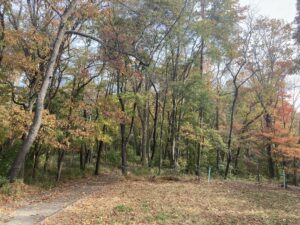I drive into work one Monday morning in October, enjoying the intense green of the trees here at the Schuylkill Center, and am greeted by a shock of yellow leaves covering the sweet birches looming over the driveway. Further down, I notice that the poison ivy winding up the cherries, too, has turned to gold since the previous Friday. A week later, the maples and sumacs turn to impossibly intense shades of scarlet and amber. Firewood reappears at the grocery store, pumpkins materialize in every shop, and I suddenly develop intense cravings for hot chocolate. Fall has finally, finally arrived.
The change of color every autumn in the deciduous forests of eastern North America is, truly, one of the greatest natural wonders of the world. Entire tourism industries are founded on the dependability of leaf peepers driving north to enjoy this finely-tuned seasonal shift. The colors of the leaves here are so bright and ephemeral that early botanists in England thought the paintings of American artists portraying the autumnal landscape in places like Pennsylvania and New England were fanciful exaggerations. American botanists had to send physical autumn leaf samples to prove to their colleagues in Europe that yes, it is all true: the forests here are quite literally unbelievably beautiful this time of year.
It may come as a surprise, then, to learn that there is not yet a scientific consensus on exactly why plants change color in the autumn. Theories abound: it is believed that trees turn more vibrant colors when they are growing in poor soil. Some think of the colors as a signal warning insect predators to stay away, or that anthocyanins (the chemicals creating red and purple in leaves) are useful as a kind of sunblock allowing the trees to break down and reabsorb leaf nutrients without getting burned by frosty winter sun. More nefarious hypotheses exist, too, about how trees change color to undermine the camouflage of herbivores whose coloration is meant to hide them from predators in the summer. Could those scarlet hillsides be a way for trees to help birds and foxes catch plant-eating prey a little more easily?
Whatever the reason for fall color, the Schuylkill Center enjoys a true showstopper every year. Our cool microclimate and unusual diversity of species provide even more beautiful shades of yellow, red, orange, and purple than other forests in the area. Lately, however, we have noticed strange things afoot. Interspersed with the glowing hues are trees still fully green in November, almost like summer never ended. Others drop everything in a rainstorm before they change and give nothing away of their autumn beauty. Some trees turn lazily from their summer to fall colors, giving less a show and more of a plodding progression toward winter dullness. This is not the sudden fireworks show of color that New England is famous for, but then again friends in Vermont and Maine have reported a less vibrant showing than usual in their neck of the woods as well. The glory of fall is undoubtedly here, but it makes its way in with a sluggish spottiness that has become increasingly normal of late. What gives?
The truth is that this process has been changing for some time now. Cold temperatures help trigger the onset of autumn foliage, and the Northeast has experienced fall temperatures above the historic average every year since 1998. Fall color has come later, and arrived with less definition, as a result. Whereas the Philadelphia area frequently had more stunning leaf displays in the past, recent history has made our autumns a more muddled affair.
It is common to think of climate change as a series of catastrophes: apocalyptic visions of possible futures-to-come in places like Australia and California that seem to never leave the news cycle, but only appear here with the occasional hurricane. The truth, however, is far more complex. Beyond the headline-grabbing disasters, climate change also affects the natural world in a variety of more subtle ways. The lessening beauty of fall foliage in the Northeast may seem like a minor outcome, but it is an ominous portent of things to come. The reality is that we simply don’t know what will happen to our forests or wildlife when their seasonal cycles shift dramatically. Every species in our region has finely-tuned requirements to thrive, and these changes that seem so small could have enormous consequences for a variety of plants and animals that we share this special landscape with.
While we have been lucky to avoid the wildfires that plague the West Coast for now, a multitude of more elusive changes are already underway here that could one day grow to be just as disastrous. The only way to stop this terrifying future from becoming a reality is to make the changes that are necessary now to ensure that our communities can live with this land in a spirit of true respect and reciprocity. Change of this scale is, of course, scary in its own way. But I curiously always have a greater sense of hope looking out at these trees here, watching as they celebrate the inevitable shift in season with a riot of beauty.
May we learn to embrace change as they do.
By Max Paschall, Land Stewardship Coordinator

